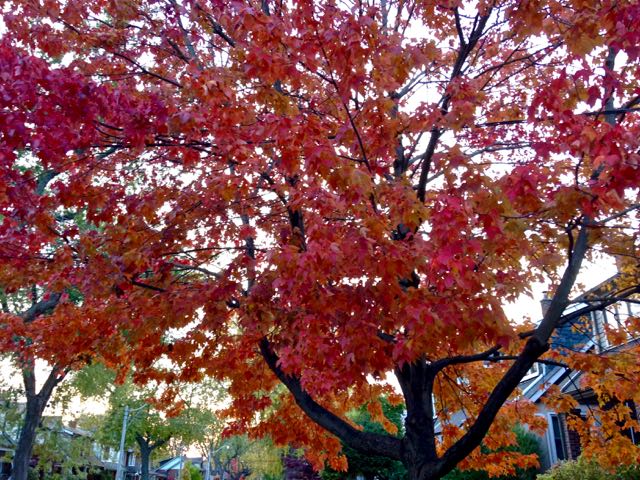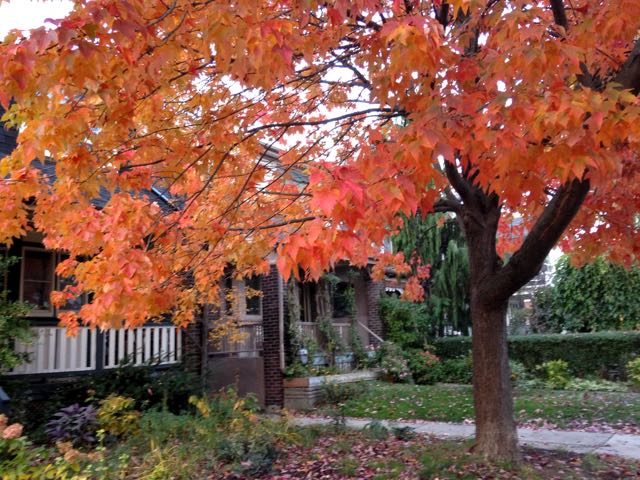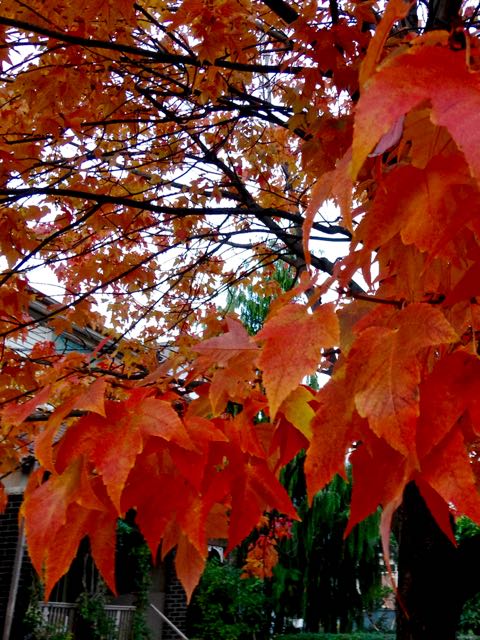Hello, I love you, won’t you tell me your name? Of course, I was talking to this beautiful tree in its red cloak, spotted in an East York garden not far from home. Every step slowed as I walked towards it and looked way up.
Was it a Freeman maple (Acer x fremanii)? More and more are appearing along Toronto’s streets, and their fall colour can be outstanding. Nope. The leaf shape was all wrong – not plentifully lobed like the Freeman’s silver maple parent (Acer saccharinum). How about red maple (Acer rubrum), the Freeman’s other parent? Red fall colour gives this tree its common name.
But the leaves didn’t look like any red maple I knew. Yes, those had three main lobes, like the one above. But, at the bottom, they usually at least hinted at the typical five-lobed maple leaf. No hint of that in the smooth leaf base. These were “crow-foot” shaped, a term I found in Michael Dirr’s Manual of Woody Landscape Plants. Plus, no maple keys that I could see. So no way to be sure if it was a maple tree at all or, if so, which it was. Stumped.
Then, reading Dirr, I got distracted by the words “male and female.” Maples have male and female trees? Huh. Some trees, I know, have separate genders, but that maples were dioecious (the term for this) was news.
Well, it turns out to be far more interesting. This links to a PDF of an article by Richard Primack called The Sex Life of the Red Maple from Harvard’s Arnoldia. He writes that red maples have not one, not two, but five separate genders. They’re termed polygamodioecious. Save that word for your next Scrabble game.
Like many plants, some red maple trees have perfect flowers, meaning the flowers are hermaphroditic with both male and female parts. Norway maples (Acer platanoides), which Toronto has in too great abundance, are examples of this.
However, other red maple trees have only male flowers; still others, only female flowers. Plus, two other gender classifications can swing both ways, depending. One of these is classed as inconstant male and the other, inconstant female. Each would be predominantly male or female, with separate flower genders on different parts of the same tree. However, the proportions of male and female flowers might differ from year to year.
In fact, none of these are unusual in the plant world. But it’s less usual for a single species to exhibit all five.
As Mr. Spock would say, Fascinating.

So trying to identify a tree species or cultivar after an innocent walk down a neighbourhood street opened up a whole new way of thinking for me. Not only about the plant world, but about all living creatures and gender identification.
We humans tend to be rigid about gender classification. Yet, humans are multi-gendered, too. In our family alone, one child identifies as bisexual and a nibling identifies as non-binary. While our culture tends to see these gender categories as aberrant, conscious choices, here is a tree with gender fluidity built by nature, right into its genes.
Acceptance has never been hard for me. Even so, I found this a bit of a revelation: Nature reinforcing what is natural. From now on, I’ll regard the few red maple trees I meet in the city with a greater sense of awe.

On top of all that, I did finally track down the likely identity of this beautiful native North American tree. All signs point to it being the ‘Red Sunset’ cultivar of red maple, aka Acer rubrum ‘Franksred’, which has that characteristic crow-foot leaf shape, along with the amazing colour. Many sources, including Dirr, describe this as being one of the best red maples for fall foliage. It certainly deserved all this praise here.
If you’re curious, you’ll be able to identify the female red maple flowers in spring by their red colour, while male flowers are yellow. Of course, only female flowers, if pollinated, would produce the winged fruit called samaras.
With so many maple trees in Toronto, I never imagined I’d be thinking about how they have sex. Did you?






